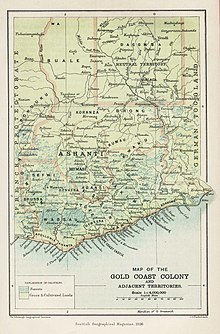Salaga area
Coordinates: 9 ° 0 ′ N , 0 ° 40 ′ W
Salaga area (also neutral zone ) was the name of an area around the city of Salaga in today's north-east Ghana, which was disputed between the colonial powers Germany and Great Britain at the end of the 19th century .
Geographical space
The Salaga area extended north-south between the mouth of the Daka River in the White Volta and the 10th parallel north. In the east and west, the borders of the Kingdom of Dagomba formed the outer boundaries , so that roughly a square area was defined as the neutral zone with the confluence of the Trubong and the Black Volta as the western border.
Reason of the establishment
In connection with the Heligoland-Zanzibar Treaty , the governments from London and Berlin discussed a. a. also about a possible border between German and British areas of influence in West Africa, d. H. also in the hinterland of the Gold Coast and the Mina (Togo) coast. A solution was first discussed, which provided for a demarcation that would incorporate large parts of the Mamprusi country and the Kingdom of Dagomba into the British sphere of influence, while the areas east of the lower Volta around Ho , Kpandu and a large part of the Peki area would be part of the German Territory would be awarded. However, no contractual agreement was reached on this issue.
One of the main reasons for an agreement not being reached was the need to divide the disputed area according to ethnic criteria in order to avoid future potential for conflict. But a border line along the White Volta, which would have largely taken this into account, seemed to the British to be unacceptable, since it was about the possession of important trading centers. After all, Salaga and Jendi were the endpoints of important trans-Saharan caravan routes. In addition, the demarcation aimed at by the British would have meant that the quite important states of the Mamprussi and Dagomba would have been divided and in both cases the residences of the most important local authorities were spread over both German and British areas of influence. In addition, part of the Mamprussi in the north would have been under French suzerainty. On the British side, too, it was clear that such a situation harbored dangerous long-term conflict potential. For example, the king of the Mamprusi resided in Gambaga , which in this case belonged to the British sphere of interest, while their most important chiefs resided in Sansanné-Mango , which was on the German side, but a large part of the agricultural production of the Mamprusi in the north was on French territory. Of course, from a British point of view, a union of the Mamprussi should take place under British sovereignty if possible, since the king was on your side. However, since no agreement could be reached, an initial agreement was reached on the establishment of a neutral zone binding on both sides.
resolution
The "neutral zone" was dissolved with a German-British agreement of November 14, 1898, which was ratified in combination with the trinational Samoa Treaty in 1899. The new border largely corresponded to the variant of a division of the kingdoms of Dagomba and Mamprusi, which was initially classified as questionable . The new German-British border in Dagomba Land ran largely along the course of the Daka river . The Mamprusi on the German side were given the option of moving to their relatives on the British side, while the Chekossi on the British side were given the option to move to German territory. Only with regard to the Dagomba did those responsible in the European governments have no concepts whatsoever, especially since the Dagomba had so far successfully opposed any form of European influence. In this question, the fact that the Dagomba king and his most important chiefs would be separated from one another by the demarcation played a role, but bitter national rivalries on the part of the two European colonial powers also came into play here, because after all, they were in the Dagomba country with Salaga and Jendi the southern endpoints of important trans- Saharan caravan routes , which opened up military control to a ruling European power and thereby the possibility of tax collection.
When the former German colony of Togo was finally divided between France and Great Britain in 1919 , the entire original Salaga area came under British rule and ultimately became part of the independent state of Ghana in 1957.
swell
- David Owusu-Ansah, Daniel Miles McFarland, Historical Dictionary of Ghana , London 1995.
- Alan EG Watherstone, The Northern Territories of the Gold Coast , in: Journal of African History , 7 (28), 1908, 344-372.
- Danckelman, Neutrale Zone , in: Deutsches Kolonial-Lexikon , Volume II, Leipzig 1920, p. 647.

